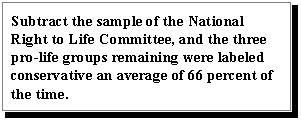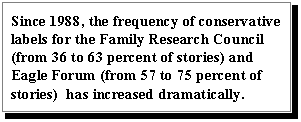Roe Warriors: The Media's Pro-Abortion Bias
Table of Contents:
- Roe Warriors: The Media's Pro-Abortion Bias
- Introduction
- 1. One side is presented as ideological, the other is not.
- 2. The abortion issue is a divisive matter in only one political party.
- 3. Reporters have shown little interest in the facts behind partial-birth abortion.
- 4. Pro-life protests and activities are not news.
- 5. Pro-abortion violence is not news.
- Recommendations for Future Fairness:
1. One side is presented as ideological, the other is not.
A new survey of 1,050 news stories in The New York Times, The Washington Post, and USA Today in 1995 and 1996 mentioning at least one of four pro-life groups or four abortion advocacy groups found the pro-life groups were labeled "conservative" in 47 percent of the news stories in which they appeared, while abortion advocacy groups were identified as "liberal" in less than three percent of the stories mentioning them.
The pro-life groups' labeling percentage was lowered by the National Right to Life Committee, whose self-explanatory name might have contributed to its comparative lack of ideological warnings, with only seven ideological labels in 119 news stories (6 percent). With the NRLC sample removed, the three pro-life groups remaining were called "conservative" or "religious right" in 171 of 259 news stories, of 66 percent. The Family Research Council attracted 115 conservative labels in 183 stories (63 percent). The June 17, 1996 USA Today carried a story by Richard Benedetto said Bob Dole might create "a nasty confrontation with those on the right who see no room for compromise [on abortion] - Pat Buchanan and the Family Research Council's Gary Bauer among them." Benedetto added: "Many moderate and independent voters already believe the GOP is caught in the grips of extremist elements hard to the right."
Subtract the sample of the National Right to Life Committee, and the three pro-life groups remaining were labeled conservative an average of 66 percent of the time.
 Concerned Women for America was tagged with an ideological label in
17 of 24 news stories about them (71 percent), while Phyllis Schlafly's
Eagle Forum drew the most ideological warnings, in 39 of 52 news
stories (75 percent). USA Today labeled Eagle Forum in all ten news stories on the group. The Washington Post
noted Schlafly was part of the "conservative alliance that challenged
Dole's tolerance language, the group that became better known as the
'fearsome foursome.'"
Concerned Women for America was tagged with an ideological label in
17 of 24 news stories about them (71 percent), while Phyllis Schlafly's
Eagle Forum drew the most ideological warnings, in 39 of 52 news
stories (75 percent). USA Today labeled Eagle Forum in all ten news stories on the group. The Washington Post
noted Schlafly was part of the "conservative alliance that challenged
Dole's tolerance language, the group that became better known as the
'fearsome foursome.'"
By contrast, the National Abortion and Reproductive Rights Action League (NARAL) drew the highest percentage of "liberal" labeling, with seven tags in 131 news stories (5 percent). Only one New York Times story kept the Feminist Majority Foundation from going unlabeled in 38 stories (2.6 percent). Despite being the nation's largest provider of abortions, Planned Parenthood was described as liberal in only seven stories out of 315 (2.2 percent). USA Today never applied in a liberal label in 64 stories, even as the newspaper noted Planned Parenthood's New York affiliate bought an ad charging conservative evangelist Pat Robertson "broadcast the words which have caused a rampage of anti-choice terrorism." The National Organization for Women drew the lowest percentage with four labels in 198 news stories (2 percent). The lack of labeling came despite millions of dollars in election-year activity on behalf of the political action committees run by NARAL, NOW, and Planned Parenthood. The lack of newspaper labeling came despite millions of dollars in the last election cycle on behalf of liberal Democratic candidates by the political action committees run by NARAL, NOW, and Planned Parenthood.
News coverage also presents the debate in the argot preferred by abortion advocates. In none of the 387 stories on pro-life groups were they ever described by reporters as "pro-life." Reporters employed the term "anti-abortion," or referred to activists as "abortion opponents" or "abortion foes." Similarly, in 682 stories on the abortion advocacy groups, none of them used the terms "pro-abortion," "abortion supporters," or "abortion advocates." Reporters referred to "abortion rights supporters."
 This newest survey corresponds with earlier Media Research Center
labeling studies, beginning in 1989, when a study of stories on CWA and
NOW in three newspapers (Los Angeles Times, New York Times, Washington Post) and three magazines (Newsweek, Time, U.S. News & World Report) in 1986, 1987, and 1988 found NOW drew only ten labels in 421 stories (2.4 percent). The Los Angeles Times offered the lion's share with six labels in 166 stories, while the New York Times never gave a label in 124 stories. (Neither did Time
magazine in ten mentions.) By contrast, CWA got labeled 25 times in 61
news accounts (41 percent), including six times in 16 stories by The New York Times.
This newest survey corresponds with earlier Media Research Center
labeling studies, beginning in 1989, when a study of stories on CWA and
NOW in three newspapers (Los Angeles Times, New York Times, Washington Post) and three magazines (Newsweek, Time, U.S. News & World Report) in 1986, 1987, and 1988 found NOW drew only ten labels in 421 stories (2.4 percent). The Los Angeles Times offered the lion's share with six labels in 166 stories, while the New York Times never gave a label in 124 stories. (Neither did Time
magazine in ten mentions.) By contrast, CWA got labeled 25 times in 61
news accounts (41 percent), including six times in 16 stories by The New York Times.
In 1991, a labeling study of groups in three newspapers (Los Angeles Times, New York Times, Washington Post) in 1988, 1989, and 1990 found reporters tacked conservative labels on the Family Research Council in 14 of 39 stories (36 percent) and Eagle Forum drew labels in 34 of 60 stories (57 percent). In 1993, analysts revisited labeling of the FRC, adding coverage in the same three newspapers from 1991 and 1992. The FRC's percentage of ideological labeling grew to 47 percent (43 of 92 news stories). Since these earlier studies, the frequency of conservative labels for the FRC (from 36 to 63 percent) and Eagle Forum (from 57 to 75 percent) has increased dramatically.
In 1994, MRC media analysts studied the pro-life Christian Coalition, which attracted a conservative label in 157 of 328 stories (48 percent). Some labels were stronger: The Washington Post used "far right" once, "hard right" once; the Los Angeles Times called them "right-wing extremists"; The New York Times termed them "hardliners"; and USA Today used the adjectives "zealous" and "vociferous" once each.
Political "Moderates" and Extremes. One way to study the use of ideological labeling by reporters is to search news stories on the interest groups involved. Another methodology is simply to look for the labels themselves. Since the media often focused on the rift over abortion in the Republican Party, it seemed strange that the pro-life side was identified using "extreme" terms, while the other extreme, favoring abortion on demand, seemed to be often identified as "moderate."
In 1996, using the Nexis news data retrieval system, we searched three national newspapers (The New York Times, USA Today, and The Washington Post) from July 1994 through June 1995, and the three weekly national news magazines (Newsweek, Time, U.S. News & World Report) from January 1992 to June 1995. To develop a sense of the print media's approach in describing the debate, we searched for the word "abortion" within 25 words of "moderate," "extreme," ""radical," "militant," "liberal," "far right," "far left," "hard right," and "hard left." In addition, we viewed all network morning, evening, and magazine show coverage from July 1, 1994 to June 30, 1995.
These major media outlets all followed a similar pattern in assigning categories in the abortion debate. In 486 newspaper and news magazine stories and more than 400 television stories (of which only 60 focused primarily on the political angle), pro-abortion Republicans were described as "moderate" in 116 stories. Pro-life Republicans were undoubtedly described most of the time as "conservative," but this limited study aimed just to identify the occurrence of imbalanced identification. Pro-life Republicans were identified with extreme terms -- "hard right," "far right," "hard-line," and "extreme right" - in 37 stories. Reporters did use the word "liberal" to describe activists in favor of abortion on 86 occasions, but not one reporter in any story used extreme labels for the liberal side. No story used the terms "far left"or "hard left" to describe abortion advocates.
As the news magazines rely more on analysis than reporting, biases were more dramatic:
"Sununu ran interference when Bush needed to shuffle to the right on such issues as judicial appointments or abortion, absorbing some of the blame of Bush's latest pander to his party's extremist wing." - Time White House reporters Michael Duffy and Dan Goodgame, August 24, 1992.
"Quayle had become the captive of and the mouthpiece for the party's farther right. Among friends, Bush put some of the blame on Marilyn Quayle for her husband's surrender. Marilyn was too shrill, too hard-core, he said. On hot-button issues like abortion, the President thought, Dan had let her push him too far right." - Newsweek's Peter Goldman and Thomas DeFrank, October 24, 1994.
"Even the velociraptors of the far right found little to lament, besides her apparent support for at least limited abortion rights." - Newsweek's David Kaplan and Bob Cohn on Supreme Court nominee Ruth Bader Ginsburg, June 28, 1993.
"Specter hopes his pro-abortion-rights stand and other moderate positions will make him an attractive alternative to the party's increasingly dominant far-right wing." - U.S. News & World Report's "Washington Whispers," November 7, 1994.
On the rare occasion when reporters would quote anti-abortion sources characterizing abortion advocates as extreme, they often put the anti-abortion source in a negative light. On June 6, 1994, U.S. News reporter Lynn Rosellini wrote of Oliver North: "Expressions like 'radical homosexuals,' 'militant feminists,' 'pro-abortion fanatics,' and 'cultural elites' roll from his tongue like caustic kisses from the Lord." When Newsweek's Lucy Howard and Carla Koehl quoted "conservative activists" distributing fliers that warned of Republican Rep. Susan Molinari's "extreme pro-abortion agenda," they immediately noted: "House sources say that the strident attack angered members, who thought it was unfair."


